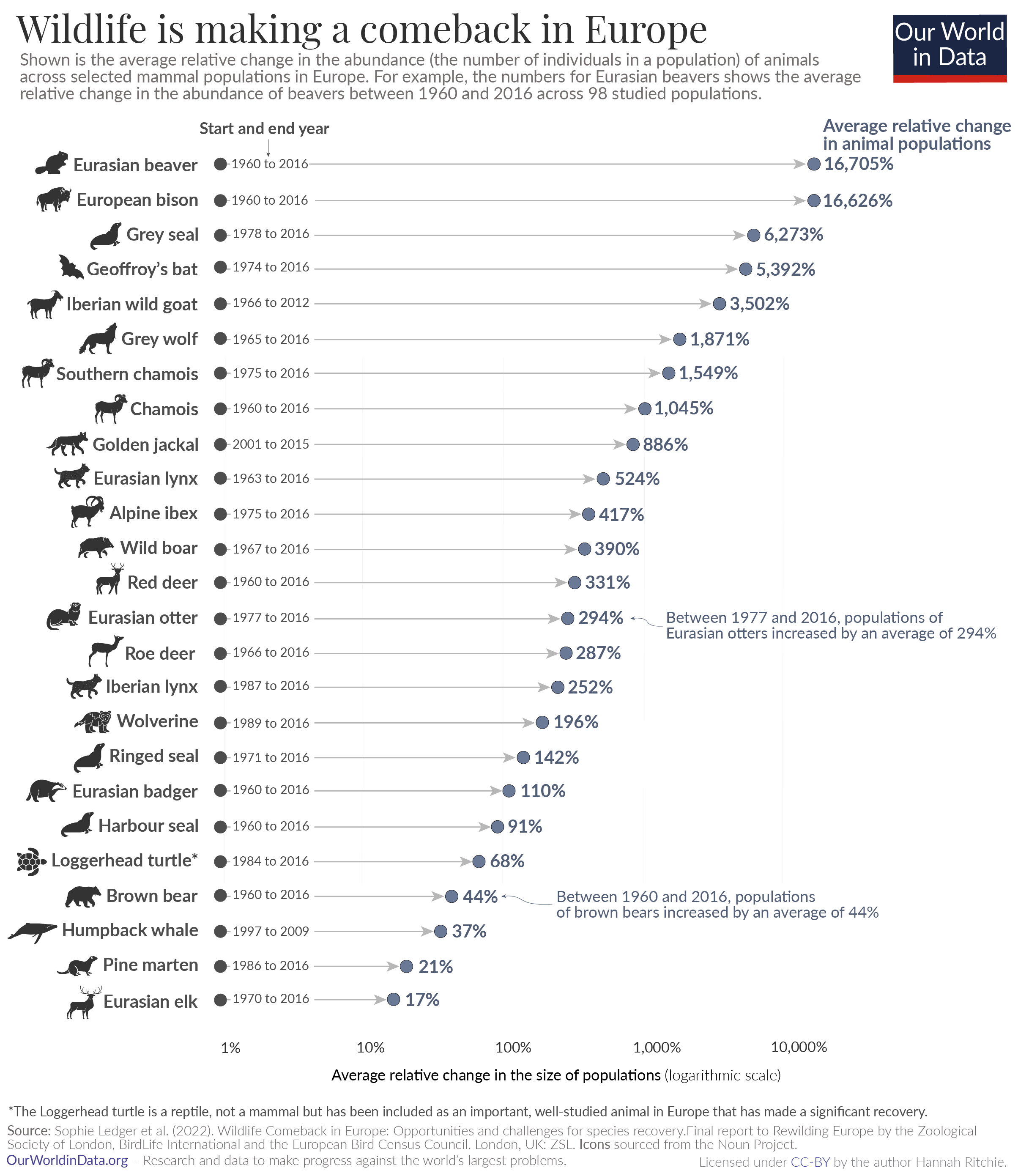Update note: This article was originally published in May 2022 based on data from the 2013 report on European mammal populations from the Zoological Society of London; Birdlife International; and Rewilding Europe. It was updated and republished in September 2022 based on the new 2022 publication of this report from these organizations.
The European bison is the continent’s largest herbivore. It was once abundant across the region. Archaeological evidence suggests that the bison was widespread, stretching from France to Ukraine, down to the tip of the Black Sea.1 The earliest fossils date back to the Early Holocene period – around 9,000 BC.
Bison populations steadily declined over millennia, but experienced the most dramatic decline over the last 500 years. Deforestation and hunting of this iconic mammal nearly drove it to extinction. Look at old cave paintings and we find that hunters had etched bison next to bison in charcoal. They had gone extinct in Hungary by the 16th century; in Ukraine by the 18th century. And by the early 20th century they had gone completely extinct in the wild, with only tens of individuals kept in captivity.
The overhunting of the bison is no outlier. It’s part of a long history. Look at the size of mammals through millions of years of human history and we find that they get smaller and smaller. Humans preferentially hunted the largest mammals, often to extinction.2
This is still the case today. It is the largest mammals that are most threatened by hunting.
But it doesn’t have to be this way, and the bison shows it. The European bison has made an impressive comeback over the last 50 years. Successful conservation efforts have seen their numbers rebound. By the end of 2021, there were almost 10,000 of them.3
It’s not the only one. Across the world, we find examples of successful conservation programs that have restored animal populations.
Here I look at the change in mammal populations across Europe. Many species are making a comeback. Once on the brink, iconic animals such as the European bison, Brown bear, and elk are thriving once again.
By the first half of the 20th century, many of Europe’s mammals had been reduced to just a fraction of their historical levels. Millennia of hunting, exploitation, and habitat loss had forced them into decline. Many had been wiped out completely.
But many mammal populations have seen a dramatic increase over the last 50 years.
A coalition of conservation organizations – including the Zoological Society of London; Birdlife International; and Rewilding Europe – periodically publish reports on how animal populations across Europe are changing. In their latest report they looked at the change in populations of 24 mammal species, and one reptile species – the Loggerhead turtle.4 The results are shown in the chart.5
Eurasian badger populations achieved an average increase of 100% – a doubling. Eurasian otters tripled, on average. For red deer this was an increase of 331%.
The Eurasian beaver has made the most remarkable recovery. It’s estimated to have increased 167-fold, on average. There were likely only a few thousand beavers left in Europe in first half of the 20th century.6 Today there are more than 1.2 million.
The European bison has achieved a similar level of comeback.
In the 2013 mammal comeback report, one species – the Iberian lynx – had shrinking populations. But, there is good news: after decades of decline, it has been making a remarkable recovery. So much so that the IUCN moved it from Critically Endangered to Endangered on the Red List in 2015. Its average population sizes are now bigger than they were in 1987.
There are more than 250 European mammal species, so the ones that we covered here represent just 10% of the continent’s mammals. The fact that these species are doing well does not mean that all species are. Nonetheless, they give us many promising examples of how animal populations can recover after a long decline.
How are these mammal populations estimated?
Long-term monitoring of wildlife populations is difficult. The methods used and the quality of estimates can change and improve over time.
In this assessment, for each mammal, researchers drew on published studies that assessed the most recent population estimates, and the change over time. These are population estimates that are included in the Living Planet Index. To address the limitations of changes in data collection, the authors only include analyses where the same methods are applied over the same time series, and the data is transparent and traceable.
This means that the data coverage may vary from species to species. For example, the result for Eurasian beavers is based on studies of 98 different populations. The grey wolf is based on 86 studies. For the Iberian lynx, high-quality time series were only available for 7 populations. In the attached spreadsheet I have included the number of populations included for each of the 25 animal species. Note that the length of time-series for each population might not all be the same length. However, in every case they are combined to calculate an overall average trend for each species.
Unfortunately, the researchers do not have complete long-term assessments for all populations for all species. This means giving an accurate starting (e.g. 1960) population level is difficult and would come with a large uncertainty.
Instead, they report the average relative change in abundance across the monitored populations for a given species.
This means, for example, that the value of 16,705% for the Eurasian beaver means that there was, on average, a 16,705% increase in the numbers of beavers in each of the 98 populations that were included in this study. This does not mean that there was a 16,705% increase in all populations. Nor can we say that there was this level of increase for Eurasian beavers as a whole because we do not know the change in unmonitored populations, and the number of beavers in different populations will be different.
How did Europe achieve this impressive recovery of mammal populations?
In short, stopping the activities that were killing mammals off in the first place. Effective protection against hunting, overexploitation, and the destruction of habitats have been key.
Agricultural land use has declined across Europe over the last 50 years. This allowed natural habitats to return where agriculture had previously taken them over.
Another essential development was to stop hunting them. Countries brought in effective protection policies such as complete bans on hunting or hunting quotas; designated areas with legal protections; patrols to catch illegal poachers; and compensation schemes for the reproduction of certain species.
Most mammals are now listed under various region-wide protection schemes with strict regulations such as the EU Habitats and Species Directive; the Bern Convention and CITES (the Convention on International Trade in Endangered Species of Wild Fauna and Flora).
In 1981 Sweden introduced hunting quotas on brown bears.7 This is thought to be the main driver of the recovery of this species. There has also been a European-wide ban on the hunting of Harbour seals, with the exception of Iceland and Norway.8 Sweden established a compensation scheme with financial rewards for the reproduction of wolverines.9 Most impressive of all, the Eurasian Beaver has not only had legal protection, it has also been reintroduced in more than 25 countries across Eurasia.10
The European bison made its comeback as the result of more than 50 years of breeding and reintroduction programs. In the 1930s, after going extinct in the wild, conservationists published the first edition of the European Bison Pedigree Book. It records the full genealogical history of all surviving bison. It was the first conservation program of its kind and it has been updated every year since.
The bison has come a long way since its first reintroduction to the wild in 1952.11 A century after going extinct in the wild, the IUCN Red List moved it from the classification of Vulnerable to Near Threatened thanks to continued conservation efforts.
One thing that has been essential has been the vital work of conservationists. From fighting for wildlife protection policies and hunting quotas, to reintroduction programmes, the dedication of determined individuals lies at the heart of this wild mammal comeback.
Keep reading at Our World in Data
Acknowledgements
I would like to thank my colleagues Max Roser, Fiona Spooner, Joe Hassel, Bastian Herre, Matt Conlen, Daniel Gavrilov, and Saloni Dattani for valuable suggestions and feedback on this article.
I would also like to thank Louise McRae and Robin Freeman from the Zoological Society of London for their feedback on this work.






